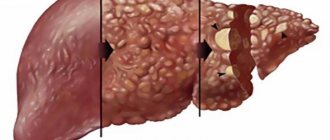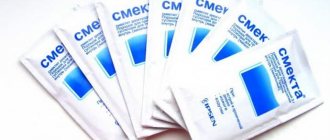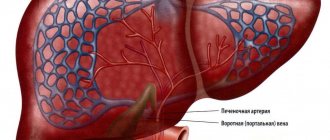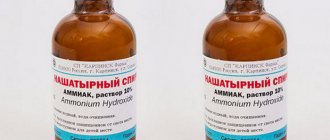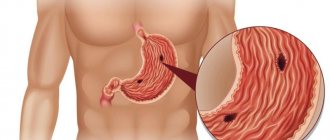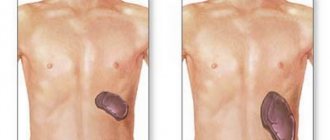The mechanism of the effect of alcohol on the liver
Once in the body, an alcoholic drink almost immediately ends up in the stomach and then in the intestines. It is absorbed into the blood through the walls and spreads through the bloodstream throughout the body, penetrating into tissues and organs.
As soon as alcohol enters the liver, the organ begins to actively produce special enzymes that promote the breakdown of ethanol. As a result, a new substance is formed - acetaldehyde, which in turn is converted into acetic acid. Acetic acid is processed by the body into water and carbon dioxide.
Liver and alcohol
First of all, the negative effect of alcohol on the liver is provoked by ethanol itself and the acetaldehyde resulting from its breakdown. Both substances are strong poisons, which gradually accumulate in the liver, contribute to obesity and cell destruction, cause inflammatory processes and, as a result, disruption of the organ. Over time, the liver no longer removes toxins so quickly, which means it is increasingly exposed to their toxic effects.
When deciding which alcohol is more harmful to the liver, you need to pay attention not only to the strength of the alcoholic drink. Chemical additives (flavors, preservatives, taste enhancers) that manufacturers add to the product are also dangerous. Also, the high sugar content in alcoholic beverages increases the burden on the body.
Pain-relieving drugs
Modern medicine has come up with many drugs to treat the liver due to its good regenerative ability. But even unconventional therapy for liver restoration requires a complete abandonment of new doses of ethyl alcohol. Medical return of the liver to life and normal functioning is based on the following means:
- Drugs aimed at direct restoration of hepatocytes usually contain phospholipids. The most popular and effective drug in this direction is Essentiale, which can start liver repair even after long binges.
- Drugs whose action is aimed at strengthening the membranes of the organ’s cells can support the liver. When hepatocytes strive to replace the function of deceased “comrades,” they increase in size, which is why it is important to strengthen their membrane structure.
- Milk thistle and preparations containing it can have a cleansing effect on the organ. This unique plant component works as a powerful adsorbent and attracts some of the toxic products with which the liver is sometimes oversaturated. Milk thistle herb perfectly optimizes the vital processes of the organ, restores its protein and lipid metabolism.
An absolute healthy lifestyle and long-term abstinence from alcohol can negate the previously inflicted toxic blow to the liver.
Sometimes cases arise when this organ hurts after drinking alcohol, but the body does not respond to drug therapy. All that remains to be done in this case is to resort to folk methods that have proven their effectiveness. Since ancient times, rose hips have been used in the form of decoctions or infusions to eliminate binge drinking and eliminate its harmful consequences. Its powerful antioxidant effect gives the organ new strength and has a beneficial effect on almost the entire body.
A decoction of rosehip is also used for a procedure called tubage, which can provoke a choleretic effect, due to which the organ is cleansed. It is necessary to make the solution for the procedure in the evening so that the rose hips poured with boiling water have time to infuse. Add xylitol to the decoction and drink the drink in small sips on an empty stomach. After which you need to lie down in bed and put a heating pad on the liver area, it is important not to make sudden movements. Almost immediately there may be a urge to defecate, which indicates the onset of the desired effect.
The procedure should be repeated once a week for three months under the strict supervision of a doctor.
Not long ago, scientists established the fact that such a sweet delicacy as marmalade, when it enters the intestines, acts as an adsorbent and absorbs toxins and toxic poisons. After a long drinking session, it won’t hurt to pamper yourself with a sweet adsorbent for the benefit of the liver.
We recommend reading:
pechen1.ru
Why is alcohol dangerous for the liver?
Regular consumption of alcohol provokes alcoholic intoxication of the liver and, as a result, the following changes:
- due to the fact that some liver cells die under the influence of toxins, fewer and fewer active cells remain, which negatively affects the functionality of the organ and significantly slows down the filtration and removal of harmful substances;
- part of the bile ducts is destroyed, bile is produced more slowly, over time this increasingly noticeably affects the functioning of the gastrointestinal tract and the body’s ability to digest and assimilate what is eaten;
- due to regular alcohol poisoning, liver tissue is gradually replaced by connective and fatty tissue, this impairs the blood supply to the organ and disrupts its function;
- after frequent drinking of alcohol, the liver enlarges, at a certain point this can lead to displacement of organs located in the abdominal cavity;
- due to a violation of the water-salt balance in the body, the increased content of sodium compounds increases, which can provoke the formation of stones in the bile ducts;
- the liver loses its ability to resist viruses, which increases the risk of contracting a variety of infectious diseases.
Conditionally safe dose
Doctors have determined how much alcohol can be consumed relatively safely for health. This classification was first introduced in the UK, but is currently used throughout the world.
Small dose of alcohol
The generally safe dose is calculated based on the amount of pure alcohol contained in the drink and is equal to:
- 330 ml beer;
- 150 ml wine;
- 45 ml of strong alcohol (more than 40% strength).
According to experts, consuming such a portion twice a week does not pose a risk to human health. These numbers are for men. Since women remove toxins from the liver more slowly, for them the generally safe dose is one third less.
Again, according to experts, less harmful alcohol is natural wine or, oddly enough, vodka, which does not contain any additional impurities. Naturally, we are talking exclusively about high-quality alcohol.
People's recommendations
Traditional medicine advice includes recipes that can minimize pain after drinking alcohol. Here are some effective recommendations:
- Brew rose hips. The result is a diuretic that speeds up the process of removing toxins and waste from the body.
- Homemade compotes based on dried fruits, raspberries, dried apricots and prunes are excellent fortified mixtures that support the functioning of hepatocytes and the gastrointestinal tract after drinking alcohol.
- Drink half a glass of cabbage juice twice a day.
When the first signs of a pathological condition appear, you should immediately stop drinking alcohol, even in small quantities. This is the only way to restore the lost functions of the gland.
Symptoms and signs of liver damage from alcohol
One of the main dangers of alcoholic liver disease is that at the first stage it is practically asymptomatic, so the pathology can be diagnosed only after a full examination.
However, sooner or later, liver poisoning with alcohol still makes itself felt and is manifested by the following signs:
- pain in the right hypochondrium (especially after fatty, heavy foods);
- digestive disorders - attacks of nausea, vomiting, diarrhea or constipation;
- skin rashes - as liver function deteriorates and metabolic disorders occur, the skin becomes dull, begins to peel, changes color, over time the rash or spots appear more and more brightly, severe itching appears;
- poor appetite, weight loss - a person intuitively begins to avoid meals after which he experiences unpleasant sensations, and due to metabolic disorders, the absorption of proteins and carbohydrates worsens.
Also, signs of liver disease in men and women suffering from alcoholism include lethargy, fatigue, and decreased performance. This condition is caused not only by depression of nervous activity, but also by a decrease in blood pressure.
Liver diseases that develop with alcoholism
Sometimes liver damage can manifest itself acutely and progress rapidly. But in most cases, the disease develops gradually, changing into an increasingly severe form. First, the liver enlarges, then obesity occurs, healthy connective tissue is replaced, the organ functions worse and worse, and eventually cirrhosis develops.
Steatosis
Steatosis or fatty liver is the first stage of organ damage, which develops as a result of metabolic disorders in liver cells. The organ cannot cope with the amount of incoming fat and begins to store some of it. Gradually, there are more and more cells filled with fat.
Liver diseases
At first, the disease does not manifest itself in any way, but later the patient may complain of pain in the right side, nausea, and vomiting. As the disease progresses, pain on the right appears more often, intensifying with movement. General weakness also appears, and as a result of weakened immunity, colds become more frequent.
Steatosis is an early reaction of the liver to alcohol, which without treatment and abstinence from alcohol will soon lead to the development of steatohepatitis.
Steatohepatitis
Fatty infiltration of the liver is aggravated by regular alcohol consumption, and steatohepatitis develops, a progressive inflammatory disease. The clinical picture in the early stages is not pronounced. Further symptoms appear such as:
- nausea, vomiting;
- apathy, constant weakness;
- pain in the right side;
- bitterness in the mouth;
- heaviness in the stomach.
Excess weight significantly increases the risk of developing steatohepatitis. There are no age restrictions, but most often the disease is diagnosed in patients over 45 years of age.
Alcoholic hepatitis
Alcoholic hepatitis can occur at any stage of alcoholic liver disease if the patient does not receive treatment. Most often, the disease is provoked by a large dose of alcohol drunk at one time. The disease develops gradually over 5–10 years. The course can be practically asymptomatic, and the signs that appear are often so nonspecific that they can indicate many different ailments.
Due to the fact that the liver processes alcohol for a long time, the patient may increasingly experience pain in the stomach and right side, heartburn, and bitter belching. The skin takes on a yellowish tint, and the liver enlarges so that it begins to protrude from under the ribs.
Liver cells destroyed by alcohol are replaced by connective tissue, which also negatively affects the functioning of the organ.
Alcoholic form of cirrhosis
Without treatment, alcoholic liver damage sooner or later leads to the development of cirrhosis. This is the most severe and practically incurable disease, which quite often leads to death. The initial stage occurs without obvious signs. The clinical picture is very similar to alcoholic hepatitis. As liver damage progresses, the following symptoms are added to the existing ones:
- joint pain;
- accumulation of free fluid in the abdominal cavity;
- the appearance of a large number of spider veins (especially on the upper body);
- bleeding gums;
- skin itching.
Also, against the background of the developing disease, the patient becomes irritable and aggressive. At this stage, any dose of alcohol, regardless of whether it is beer or vodka, can cause a sharp deterioration and cause hepatic coma.
When should you see a doctor?
At the first symptoms of intoxication, it is recommended to consult a doctor.
You should urgently contact a medical professional in the following situations:
- If your liver is sick.
- When the right side hurts.
- Severe intoxication - high body temperature is noted, vomiting or loss of consciousness has developed.
- Alcohol intoxication continues for several days, that is, after binge drinking.
If such or any other disorders occur, you should contact a gastroenterologist or hepatologist. Emergency qualified assistance can also be provided by a therapist or emergency physician. At the medical center, the patient undergoes a diagnostic blood test, liver ultrasound, or MRI to identify signs of pathological processes.
Possible complications
Any of the alcoholic liver diseases can cause serious complications. The most common of them:
- anemia;
- bleeding in the gastrointestinal tract;
- cardiac dysfunction;
- disorders of the kidneys;
- renal and liver failure;
- encephalopathy.
Bleeding
ALD also significantly increases the risk of liver cancer.
Forms of treatment
Alcoholic liver disease can be cured. The most favorable results are achieved by treatment started in the early stages, but even with severe liver damage it is possible to achieve stable remission. For this, complex therapy is used, but the main condition is complete abstinence from alcohol.
Treatment consists of several stages:
- first of all, it is necessary to carry out detoxification as quickly as possible - remove toxins from the liver;
- then drug therapy is used (sorbents, hepoprotectors, antibiotics, lactulose preparations);
- normalization of nutrition (following a specially selected diet).
Liver diseases are very dangerous and have a negative impact on the condition of the entire body. If your liver hurts after drinking alcohol, the best thing you can do is see a doctor and get examined so that, if necessary, treatment can begin as soon as possible.
Primary care at home
The main reason why pathological processes begin to occur in the body is the consumption of alcohol. When the condition is relatively satisfactory, then after drinking you can help yourself at home. During treatment, alcohol-containing liquids are prohibited.
Cleansing enema
When deciding what to do if your liver hurts after drinking alcohol, it is recommended to start with a cleansing enema. This is a good manipulation that helps to quickly eliminate toxic substances and metabolites that have a detrimental effect on liver and brain cells.
The patient can use ordinary clean boiled water or a weak solution of potassium permanganate (barely pink). The solution should be 18-22 degrees. Warm water is not suitable because it is quickly absorbed in the intestines.
Sequence of stages of gland cleansing:
- For manipulation at home, you need to use a rubber heating pad with an adapter and a plastic tip or an Esmarch mug.
- The amount of liquid for the cleansing procedure is 1500-2000 ml.
- The patient lies on his side and pulls his knees toward his stomach.
- Lubricate the tip with Vaseline, insert it into the rectum - 3-4 cm towards the navel, and then 5-6 cm parallel to the spine.
- Remove the clamp, introduce an aqueous solution or with the addition of potassium permanganate.
- Then squeeze your buttocks and lie down for 15-20 minutes.
- Afterwards, empty your bowels.
If the attack of pain is acute, nausea and vomiting, the manipulation is carried out several times. Second time after 2 hours.
Application of enterosorbents
When your liver hurts after drinking alcohol, you need to take enterosorbents. These are groups of drugs that bind and remove dangerous compounds from the body. Toxins leave the body naturally - during bowel movements.
Enterosorbents:
- Activated carbon. Should be taken after vomiting. Calculate the dosage based on the patient’s body weight. One tablet per 10 kg.
- Smecta is a medicine in powder form. For several days, take 2 sachets, dissolving in water.
- Enterosgel is a medicine for internal use. Available in the form of a suspension, you can wash it down with a small amount of clean liquid.
An equally effective drug is white coal. You don't need to take a lot of pills, which is convenient because of vomiting.
Use of hepatoprotectors
If the liver hurts after alcohol, hepatoprotectors are used for treatment.
These medications protect the liver from negative effects, can increase the functionality of the organ, and accelerate regeneration processes.
They also remove toxins.
For alcohol intoxication, medications can be used:
- Karsil or Gepabene. These are herbal medicines. Binds and removes toxic components from the body.
- Essentiale Forte is a drug related to phospholipids. Well tolerated, rarely leads to the development of negative effects.
As an alternative, the drugs Ursoliv and Ursofalk, where the active substance is ursodeoxycholic acid, are suitable. The drugs improve the functionality of the entire hepatobiliary system, stimulate the process of production and discharge of bile, and accelerate the removal of poisons and metabolites from the body.
To treat disorders in the liver, not only enterosorbents and hepatoprotectors are used, but also drugs from other pharmacological groups - antibiotics, non-steroidal anti-inflammatory drugs, antioxidants, etc. The regimen is individual, depending on the cause of the problems with the gland.
Folk remedies
Alternative medicine offers many recipes that are effective for alcohol intoxication.
They are used as an adjuvant for severe iron damage or as a single agent in mild cases.
Effective recipes:
- Cleansing the liver with rose hips. The fruits provide moderate diuretic and choleretic effects. To cleanse the house, brew it and drink it like tea. Proportions – a tablespoon of rosehip per 250 ml of hot water. Drink 250 ml three times a day, treatment for 2 weeks.
- Cabbage juice helps restore and strengthen hepatocytes. Drink 120 ml every day in the morning and evening. Treatment lasts 1 week.
- Lingonberries and currants help with intoxication. Make tea based on the fruit or eat it like this (if there is no vomiting).
A combination of honey and radish juice helps to cope with alcohol intoxication. You need to mix 500 ml of juice with 200 ml of honey. The dosage is 30 ml, taken 2 times a day, regardless of meals. Course duration is 2 weeks.
Chronic alcoholism and the liver
If a person systematically drinks alcohol for a long time, changes occur in his body that become irreversible over time. A damaged liver can no longer provide complete detoxification and toxic substances gradually accumulate in the body, affecting the functioning of all organs.
Regular toxic load increasingly slows down the recovery processes, which causes organ pathologies. If you do not get rid of alcohol addiction and start treatment, the development of serious illnesses cannot be avoided. Depending on the characteristics of the body, they will develop at different speeds, but gradually the person’s condition will only worsen.
Causes
Let's try to figure out why there is pain in the liver after drinking? Any toxic substances that enter our body are filtered by the liver. It is not difficult to guess that the more toxic substances there are, the more stress it will be for her to cleanse the blood saturated with these substances. Ethyl alcohol in the quantities in which many are accustomed to consuming it is poisonous, so the liver, experiencing increased stress, becomes overfilled with blood and retains toxic substances, which provokes inflammation and hypertrophy.
Can your liver hurt? In the liver itself, as we know, there are no pain endings, so the fibrous membrane, which it stretches, hurts. The gallbladder and its ducts may also hurt. The main cause of the disease is long-term alcohol abuse.
The rate of development of alcoholic hepatitis depends on the type of drinks consumed, the daily volume, the frequency of their intake, the duration of alcohol abuse, as well as the individual characteristics of the body.
The development of the disease is often observed in people who are poorly nourished, have had viral hepatitis, or have a genetic deficiency of enzymes that utilize alcohol.
